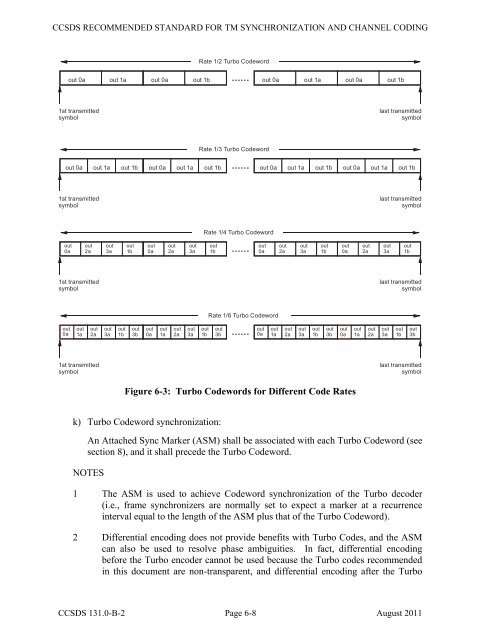ccsds 131.0-b-2
ccsds 131.0-b-2
ccsds 131.0-b-2
- No tags were found...
Create successful ePaper yourself
Turn your PDF publications into a flip-book with our unique Google optimized e-Paper software.
CCSDS RECOMMENDED STANDARD FOR TM SYNCHRONIZATION AND CHANNEL CODINGRate 1/2 Turbo Codewordout 0a out 1a out 0a out 1b ...... out 0a out 1a out 0a out 1b1st transmittedsymbollast transmittedsymbolout 0a out 1a out 1b out 0a out 1a out 1bRate 1/3 Turbo Codeword......out 0a out 1a out 1bout 0a out 1a out 1b1st transmittedsymbollast transmittedsymbolRate 1/4 Turbo Codewordout0aout2aout3aout1bout0aout2aout3aout1b......out0aout2aout3aout1bout0aout2aout3aout1b1st transmittedsymbollast transmittedsymbolRate 1/6 Turbo Codewordout0aout1aout2aout3aout1bout3bout0aout1aout2aout3aout1bout3b......out0aout1aout2aout3aout1bout3bout0aout1aout2aout3aout1bout3b1st transmittedsymbollast transmittedsymbolFigure 6-3: Turbo Codewords for Different Code Ratesk) Turbo Codeword synchronization:An Attached Sync Marker (ASM) shall be associated with each Turbo Codeword (seesection 8), and it shall precede the Turbo Codeword.NOTES1 The ASM is used to achieve Codeword synchronization of the Turbo decoder(i.e., frame synchronizers are normally set to expect a marker at a recurrenceinterval equal to the length of the ASM plus that of the Turbo Codeword).2 Differential encoding does not provide benefits with Turbo Codes, and the ASMcan also be used to resolve phase ambiguities. In fact, differential encodingbefore the Turbo encoder cannot be used because the Turbo codes recommendedin this document are non-transparent, and differential encoding after the TurboCCSDS <strong>131.0</strong>-B-2 Page 6-8 August 2011
















